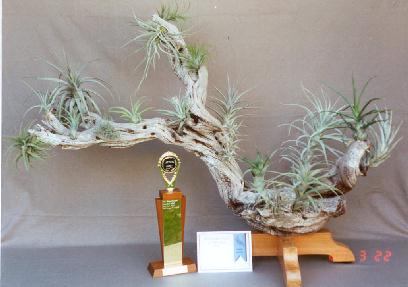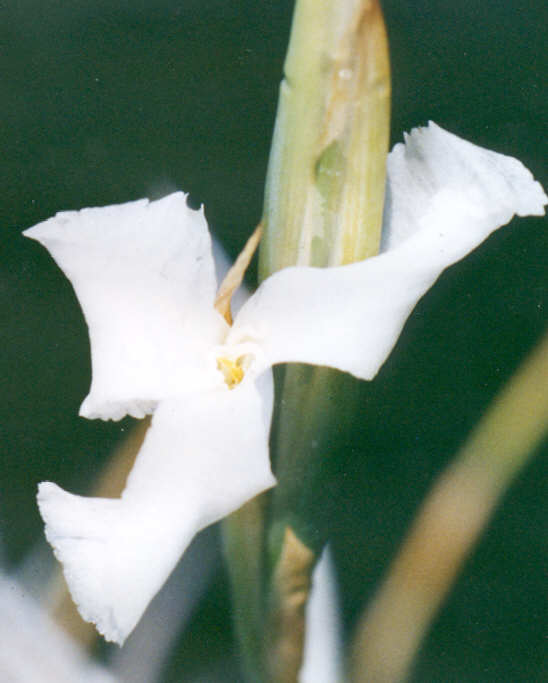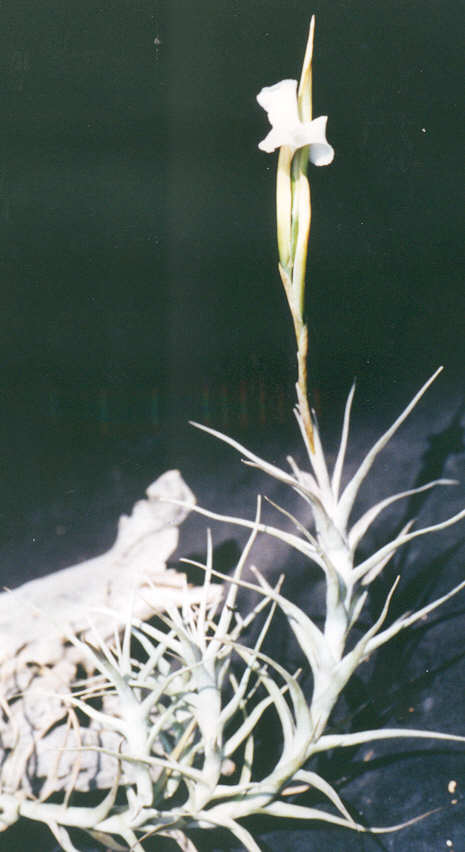
The name is not as bad as it sounds because it was a tree root that Ivy Kirby (now deceased) had under her bench for many years and thought George could do something with. All it needed was a bit of ingenuity and expertise.
November Sales Day
Everything went off smoothly and despite less people coming through the door we made a little bit more than last years. Could the water restrictions be having an effect? We Bromeliad growers know that in many cases the only place you can find water in the wild Jungle after a dry spell is in a Bromeliad! Could those who entered their names to the mailing list when we first started this service and have filled their collections? Do they stay on the list just in case?
We were lucky to get Jeanne Hall to have a word in Sophie Thompson’s ear so we got a good spread in the Sunday Mail WITH coloured picture. The picture was of Peter Hall’s collection when it was small!
Advertisement in ‘What’s on this weekend’ in the Advertiser. Who noticed that it had a starting time of 9am instead of 10am. When I was aware of this, I kept thinking up comments I could make to irate customers knocking on the door before 10am. Guess what? Not a murmur - suggesting nobody read it and that the $60 cost could be spent elsewhere.
Amendments to the selling area and 2 imports from Victoria helped make the workers and customers happy. At 1pm the workers were caught having a chat which they felt was justified because there were no new customers. They said they had to gird-up-their-loins ready for the 2pm rush which did not occur!
Most sellers were happy by the time 3.30pm came around except for two over-optimistic ones. At least they have stock ready for the March Show.
November meeting from the Secretary’s desk
We are participating with a small stand at the ABC Gardening Show at Wayville at the end of February. A one page blurb is shown elsewhere in this edition. While we will have rostered personnel present it would be a good experience for others to come along just for the ride.
Before we let open the afternoon tea tables to all and sundry we allowed Len to have a few minutes talking about the plants that had been brought in for display. These were mainly those he had brought in on the Saturday but we were all too busy at that time to listen to his talking! One exception was a rejuvenated ‘Ivy’s root’ loaded with tillandsias by George Rudolph.



Plant swaps went off without a hitch and then it was into the Auction. I always think of this as a fun auction but it is interesting how competition can be a serious business. Bill Treloar was at the fore with his $1 to $2 bids and it was surprising what amount of loot he will take back to Bute to replenish his Nursery Stocks. Most lots went for below value which is great for the new member who wants to get involved. It is something that those who only come to our Sales miss out on!
Competition in bidding reminds me of Ebay and how some people get caught up in the frenzy, and pay extraordinary prices for plants claimed to be unique. I have even heard of a person leaving work to concentrate purely on re-selling Bromeliads on Ebay. By this I mean buying at say a meeting and then selling. I wonder how long this bubble will last. Luckily very little active hybridising is done in South Australia but is very prevalent in NSW and Queensland and the following is how I am trying to get the message over that if you do bring new plants into the world you should act responsibly almost as much as you would in starting new human babies.
Times are achanging by Derek Butcher.
Do you want the good news or the bad news? We now have 8821 names on the International Bromeliad Cultivar Register of which 4366 are Neoregelia. If you wanted to buy one of these plants how lucky would you be? Many of the older ones would be very difficult to find. With many of the newer ones you could try contacting the hybridist but even then you could have problems. Let me explain.
In the good-old-days, Nurseries printed catalogues and advertised their wares in various newsletters and journals. However, as Herb Plever from New York has already pointed out these catalogues are becoming few and far between and yet plants, especially hybrids, are still sold and purchased around the world.
Ever since I became Registrar in 2000 I have tried to point out the advantages of registering hybrids if only to give some way of identification compared to the names that just occur in Catalogues, which for want of a term I have always called nurserymen’s names or NN for short.
Another reason for having a Cultivar Register is that anybody wanting such a plant could at least contact the hybridist and in the good-old-days this was a reasonable assumption. Catalogues were invaluable in this exercise because the nuseryman had to have sufficient stock before going to the expense of printing such catalogue. Therefore he worked with propagating offsets. Having available stock is all the more important to the large wholesalers in Europe and some larger US concerns. Here, it can be said that the plants are truly being cultivated widely and need to be recorded in the Register. If I find out they are using a different name for this same plant this is also recorded in the Register whether the company concerned likes it or not. The same name for different plants is also recorded. So the Register is more than just a register because it gives extra information in any search for identity.
We have the rule for registering hybrids that the plant should be grown through successions of asexual reproduction to ensure that 1. There is a chance to look at stability and 2. There is a likelihood that there are sufficient numbers for circulation for it to be considered a plant in general cultivation.. This is decided by the registrant/hybridist not the Registrar. And if we return to the good-old-days there was no incentive to ignore this rule!
These days of Ebay and Websites it costs no more to have just one cultivar for sale, calling it unique, and claiming a high price for it. The purchaser is not fully aware that the onus is him/her to propagate such cultivar and in reality it is unnecessary to be in the Register because nobody else has a chance of obtaining it or needing to know its identity. This uniqueness is a decision by the seller. This is where we have problems with Bromeliaceae because of their promiscuity and fecundity where every seed raised has the potential to be ‘different’ in someone’s eyes. Culling is always urged but rarely put into practice because its meaning differs amongst individuals.
The Registrar treads a narrow path between the thousands of named plants out there not registered and the few thousand that have been. How many growers keep the labels near their plants? I have had one nurseryman boast that over the years he had named and sold some 60,000 plants without registering one. What I find interesting is that NOT one has been referred back to me with an identity crisis. This means to me that the plants could not have been that outstanding in the first place for purchasers to want to propagate them further. This also shows that you do not need to register every seedling you obtain, and just one of my sayings is ‘Quality before Quantity’
Bromeliad Societies around the world play a vital role in this selection process when they conduct Shows and issue Newsletters, and check the Cultivar Register to see if the plant name has been registered. How many registered plants turn up on Show benches?
METAMASIUS CALLIZONA IS DESTROYING FLORIDA'S NATIVE BROMELIADS by Howard FRANK and Ronald CAVE at Second Symposium on Biological Control of Arthropods 2006
Bromeliads (Bromeliaceae) are a family of about 2,500 species native to the Neotropics, with 16 native to Florida. For decades, enthusiasts have imported into Florida numerous species from Neotropical countries for their attractive foliage and colorful flowers. The impression of enthusiasts, still fostered by growers' manuals, was that bromeliads have no serious pest insects - only a few easily controllable scale insects and mealybugs (Coccoidea). In 1989, an unidentified weevil was detected on ornamental bromeliads at a nursery in Ft. Lauderdale. The nursery was treated with chemicals to eradicate the population, but too late - surveys showed that this weevil was established on native Florida bromeliads in nearby county parks. It was Metamasius callizona (Chevrolat) (Coleoptera: Dryophthoridae, formerly Curculionidae). It had been shipped from infested shadehouses in the state of Veracruz, Mexico. USDA-APHIS records showed interceptions year after year of this and other Metamasius weevils on bromeliads imported to Florida. There was little knowledge of it in Mexico except as an occasional pest of cultivated pineapples, which was unpublished information at the time. A chemical eradication attempt was not supportable because (1) the weevil was already in county parks that may not be treated with chemicals, and (2) there were no funds except for eradication of major agricultural pests. Bromeliad enthusiasts called for research but could raise little money. Their immediate needs were met by the discovery that carbaryl (Sevin®) would control bromeliad weevil in plant collections. As the multivoltine weevil population spread from county to county destroying native bromeliad populations and invading state parks, botanists of Florida's Endangered Plant Advisory Council became alarmed and declared two more of Florida's native bromeliad species to be endangered (Florida Administrative Code). Brief searches for potential biological control agents were carried out in Mexico, Panama, and Honduras. In Honduras, an undescribed fly (Diptera: Tachinidae, cf. Lixophaga sp.) was found as a parasitoid of the closely related M. quadrilineatus Champion, a species that inhabits remnant cloud forests on hilltops. Climatic conditions could not be duplicated in Florida's unsuitable main quarantine facility, and attempts to rear this fly failed. Recently, Florida Park Service personnel saw the devastation to native bromeliad populations and became alarmed. Increased funding led to further exploration in Guatemala, Belize, Mexico (again) and even Paraguay for candidate biological control agents. None, other than the Honduran tachinid fly (also found in Guatemala), was detected. Research efforts were then concentrated in Honduras where adequate stock of the fly could be obtained and maintained at temperatures cooler than obtainable in Florida's Gainesville quarantine facility. Stock of M. callizona and M. mosieri Barber (a native Florida non-pest species) has been supplied to Honduras for tests. A new Biological Control Research and Containment Laboratory at Ft. Pierce has just become operational. At time of writing, the weevil's population was outside the northern edge of Everglades National Park.
Table 1. Florida bromeliad species, their abundance and status under Florida law, and susceptibility to attack by M. callizona larvae.